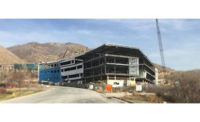Related Link:
ENR 2023 3Q Cost Report PDF
(Subscription Reguired)
Labor shortages and inflationary pressures continue to push up craftworker wages with recent settlements trending toward levels not seen in decades. Both union settlements and open shop pay are on the rise, as employers grapple with how to attract and retain workers to meet continued high demand.
This year, first-year increases in union labor settlements reached 4.4% by the end of the second quarter—a significant jump from 3.6% in second quarter 2022, according to data from the Construction Labor Research Council’s Settlements Report for that period. That 0.8% bump the report shows matches the same rate of increase seen between second quarter 2021 and the same period in 2022.
Carey Peters, council executive director, notes that because union settlements are almost always multi-year contracts, the current increases trail demand. “We’re seeing a lag effect,” he says. “There will be some who are bargaining who want to catch up to that high inflation we experienced a year or two ago.”
As a result, Peters says more recent settlements suggest that upward trend will continue this year—noting that current first-year settlements are on track to equal or surpass the high watermark of 4.6% that was set in 2008.
Despite some continued uncertainty in the economy, Peters says settlement durations are averaging three years. “It shortened during COVID, but we appear to be back to the typical three-year contracts,” he points out. CLRC data for the first half of 2023 shows that the highest first-year increases tended to be on the west coast, led by the northwest at 5.6%. Conversely, the east coast is generally on the low end of the increase range, with New England settlements averaging 3%.
In the first half of the year, the highest increases are reported for union laborers [5.2%], pipefitters/plumbers [5.1%] and carpenters [5.1%], while glaziers are the lowest at 2.9%.
Current economic pressures continue to drive contract discussions in 2023, according to Mark Breslin, CEO of union contractor group United Contractors in California. “You’ve got unprecedented labor demand matched with unprecedented inflation,” he contends. “Those two combined are profoundly impacting expectations.”
Breslin says he sees the percentage of settlement increases on the west coast trending in the “high fours and fives, which are the largest increases that I’ve seen during my tenure.”
Although settlements tend to offer steady increases throughout the duration of a contract, some are front-loading them to help address current cost of living challenges.
Chuck Hubler, executive director of the Plumbing and Mechanical Contractors Association of Oregon, says his group reached a 14.5% three-year settlement in March with its union partners. The agreement provides a 6.5% increase in year one, 4.5% in year two and 3.5% in year three.
According to Hubler, current concerns over cost of living drove the negotiations. “In order to get over that huge hurdle, we decided to front load [the contract],” he says. Hubler notes that because the union’s health and welfare reserves are strong and pensions are well funded, most of the increases will go toward wages.
Jason Watson, executive director of labor relations for the Sheet Metal and Air Conditioning Contractors’ National Association, agrees that having benefit packages on solid footing has helped with negotiations, as large percentages of current settlements go directly to wages. “There were years after the last economic downturn when total package increases went strictly to benefits,” he recalls.
While non-construction unions such as the United Auto Workers are experiencing strikes, Watson also notes that construction unions and employers have generally avoided them in recent years. He credits years of ongoing partnering sessions between unions and contractor associations for easing potential tensions that could otherwise arise during contract negotiations. “At least in the sheet metal industry, folks are working well together,” he adds.
Although lagging behind, union settlement increases are mirroring open shop trends. Wage increases for non-union workers rose from an average of 4.6% in 2021 to 5.1% in 2022, according to the 2023 Merit Shop Wage and Benefit Survey published by consultant PAS Inc. Laborers, cement finishers and electricians saw some of the highest increases, all topping 7%. Unlike union settlements, New England reported the highest increases at 5.6%. Among the states, Colorado and Florida report the largest spikes.
PAS President Jeff Robinson says survey respondents forecast that wages would increase by 4.45% on average this year. However, he says data suggests that wages will likely remain at a high point this year and into next year. “It’s going stay above 5%,” he says. “I would say we’re probably looking at 5.2% to 5.3% next year.”
For unions, the future could be determined by the flurry of mega-projects that are projected to hit the market in the coming years, particularly ones with significant federal funding. Breslin says that legislation such as the CHIPS Act, which aims to boost domestic semiconductor manufacturing, the Infrastructure Investment and Jobs Act and continued investment in both traditional and clean energy projects will drive demand for more union craft members for the next decade. “I see boom times running another 10 years, at least from an industrial and energy market perspective,” he predicts. “We see megaprojects on the horizon for a long time.”



Post a comment to this article
Report Abusive Comment